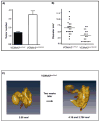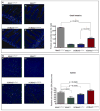An Msh2 conditional knockout mouse for studying intestinal cancer and testing anticancer agents
- PMID: 19931261
- PMCID: PMC2862591
- DOI: 10.1053/j.gastro.2009.11.009
An Msh2 conditional knockout mouse for studying intestinal cancer and testing anticancer agents
Abstract
Background & aims: Mutations in the DNA mismatch repair (MMR) gene MSH2 cause Lynch syndromes I and II and sporadic colorectal cancers. Msh2(null) mice predominantly develop lymphoma and do not accurately recapitulate the colorectal cancer phenotype.
Methods: We generated and examined mice with a conditional Msh2 disruption (Msh2(LoxP)), permitting tissue-specific gene inactivation. ECMsh2(LoxP/LoxP) mice carried an EIIa-Cre transgene, and VCMsh2(LoxP/LoxP) mice carried a Villin-Cre transgene. We combined the VCMsh2(LoxP) allele with either Msh2(Delta7null) (VCMsh2(LoxP/null)) or Msh2(G674D) mutations (VCMsh2(LoxP/G674D)) to create allelic phase mutants. These mice were given cisplatin or 5-fluorouracil/leucovorin and oxaliplatin (FOLFOX), and their tumors were measured by magnetic resonance imaging.
Results: Embryonic fibroblasts from ECMsh2(LoxP/LoxP) mice do not express MSH2 and are MMR deficient. Reverse transcription, polymerase chain reaction, and immunohistochemistry from VCMsh2(LoxP/LoxP) mice demonstrated specific loss of Msh2 messenger RNA and protein from epithelial cells of the intestinal tract. Microsatellite instability was observed in all VCMsh2 strains and limited to the intestinal mucosa. Resulting adenomas and adenocarcinomas had somatic truncation mutations to the adenomatous polyposis coli (Apc) gene. VCMsh2(LoxP/LoxP) mice did not develop lymphoma. Comparison of allelic phase tumors revealed significant differences in multiplicity and size. When treated with cisplatin or FOLFOX, tumor size was reduced in VCMsh2(LoxP/G674D) but not VCMsh2(LoxP/null) tumors. The apoptotic response to FOLFOX was partially sustained in the intestinal mucosa of VCMsh2(LoxP/G674D) animals.
Conclusions: Msh2(LoxP/LoxP) mice in combination with appropriate Cre recombinase transgenes have excellent potential for preclinical modeling of Lynch syndrome, MMR-deficient tumors of other tissue types, and use in drug development.
Copyright 2010 AGA Institute. Published by Elsevier Inc. All rights reserved.
Figures






Comment in
-
A knockout for Lynch syndrome.Gastroenterology. 2010 Mar;138(3):820-2. doi: 10.1053/j.gastro.2010.01.020. Epub 2010 Jan 25. Gastroenterology. 2010. PMID: 20102757 Free PMC article. No abstract available.
Similar articles
-
Temozolomide increases the number of mismatch repair-deficient intestinal crypts and accelerates tumorigenesis in a mouse model of Lynch syndrome.Gastroenterology. 2014 Nov;147(5):1064-72.e5. doi: 10.1053/j.gastro.2014.07.052. Epub 2014 Jul 31. Gastroenterology. 2014. PMID: 25088490
-
A knockout for Lynch syndrome.Gastroenterology. 2010 Mar;138(3):820-2. doi: 10.1053/j.gastro.2010.01.020. Epub 2010 Jan 25. Gastroenterology. 2010. PMID: 20102757 Free PMC article. No abstract available.
-
Mesalazine and thymoquinone attenuate intestinal tumour development in Msh2(loxP/loxP) Villin-Cre mice.Gut. 2015 Dec;64(12):1905-12. doi: 10.1136/gutjnl-2014-307663. Epub 2014 Nov 26. Gut. 2015. PMID: 25429050 Free PMC article.
-
The Clinical Outcomes Among Patients Under 60 Years Old with Lynch Syndrome: Variations Based on Different Mutation Patterns.Int J Mol Sci. 2025 Apr 4;26(7):3383. doi: 10.3390/ijms26073383. Int J Mol Sci. 2025. PMID: 40244260 Free PMC article. Review.
-
[Lynch syndrome and microsatellite instability: a review].Rev Med Liege. 2012 Dec;67(12):638-43. Rev Med Liege. 2012. PMID: 23342874 Review. French.
Cited by
-
Defects in MMR Genes as a Seminal Example of Personalized Medicine: From Diagnosis to Therapy.J Pers Med. 2021 Dec 8;11(12):1333. doi: 10.3390/jpm11121333. J Pers Med. 2021. PMID: 34945805 Free PMC article. Review.
-
The path to metastatic mouse models of colorectal cancer.Oncogene. 2018 May;37(19):2481-2489. doi: 10.1038/s41388-018-0155-x. Epub 2018 Feb 21. Oncogene. 2018. PMID: 29463860 Review.
-
A novel mouse model of cerebral cavernous malformations based on the two-hit mutation hypothesis recapitulates the human disease.Hum Mol Genet. 2011 Jan 15;20(2):211-22. doi: 10.1093/hmg/ddq433. Epub 2010 Oct 11. Hum Mol Genet. 2011. PMID: 20940147 Free PMC article.
-
Mouse models for colorectal cancer.Am J Cancer Res. 2013 Jun 20;3(3):240-50. Print 2013. Am J Cancer Res. 2013. PMID: 23841024 Free PMC article.
-
Advancing translational research for colorectal immuno-oncology.Br J Cancer. 2023 Oct;129(9):1442-1450. doi: 10.1038/s41416-023-02392-x. Epub 2023 Aug 10. Br J Cancer. 2023. PMID: 37563222 Free PMC article. Review.
References
-
- Fishel R, Lescoe MK, Rao MR, et al. The human mutator gene homolog MSH2 and its association with hereditary nonpolyposis colon cancer. Cell. 1993;75:1027–38. - PubMed
-
- Lothe RA, Peltomaki P, Meling GI, et al. Genomic instability in colorectal cancer: relationship to clinicopathological variables and family history. Cancer Res. 1993;53:5849–52. - PubMed
-
- Marsischky GT, Filosi N, Kane MF, et al. Redundancy of Saccharomyces cerevisiae MSH3 and MSH6 in MSH2-dependent mismatch repair. Genes Dev. 1996;10:407–20. - PubMed
-
- de Wind N, Dekker M, Berns A, et al. Inactivation of the mouse Msh2 gene results in mismatch repair deficiency, methylation tolerance, hyperrecombination, and predisposition to cancer. Cell. 1995;82:321–30. - PubMed
-
- Reitmair AH, Schmits R, Ewel A, et al. MSH2 deficient mice are viable and susceptible to lymphoid tumours. Nat Genet. 1995;11:64–70. - PubMed
Publication types
MeSH terms
Substances
Supplementary concepts
Grants and funding
LinkOut - more resources
Full Text Sources
Other Literature Sources
Molecular Biology Databases
Research Materials

